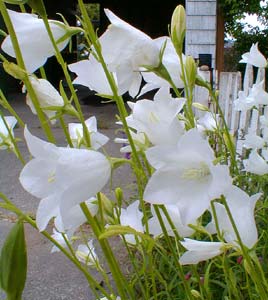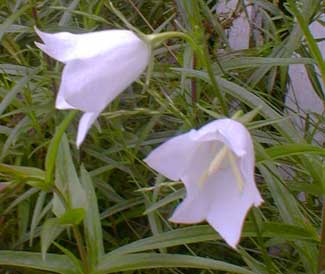
White Peachbell,
a classic Bell Flower
"The garden's silence: even the single bee
Persisting in his toil, suddenly stopped,
And where he hid you only could surmise
By some campanula chalice set a-swing.
Who stammered--"Yes, I love you?"
-Robert Browning
(1812-1889)
(1812-1889)
Campanula persicifolia is an Asian species that has naturalized in many regions of the the United States as well as in England, so that it has become a common wildflower in moist open wooded areas.
In the garden it self-seeds & spreads liberally with scant encouragement. We have white ones & blue ones that were given to us by a friend who had them springing up in unexpected locations. The blues are more persistent in self-seeding. The whites do also self-seed but a high percentage of them are pale blue rather than purely 'Alba.'
 C. persicifolia 'Blue' as well as 'Alba' were in cultivation in England by the late 1590s. The double-forms now considered standard have been grown in English gardeners by 1665.
C. persicifolia 'Blue' as well as 'Alba' were in cultivation in England by the late 1590s. The double-forms now considered standard have been grown in English gardeners by 1665.The bulk of the leaves form a clumping basal rosette, with leafed flower stems rising upward to as high as four feet though not usually quite that tall, making C. persicifolia rather taller than, though not so sturdy as, the C. medium 'Canterbury Bells' which has stronger stems.
Called either Peachleafed Bellflowers, or Peachbells, the "Peach" alludes not to a color form, but to the appearance of the leaves, serated & lance-shaped like leaves of a peach tree. The tallest stems can be tippy from the weight of their flowers, but with ours positioned next to a picket fence, the fence keeps them largely upright.
C. persicifolia var. alba 'White Peachbells' is sometimes called White Willow Bellflower. A clump can spread by rhizomes to a two-foot width, but when it gets that big it begins to tire & wear out, so should be dug up & divided every third or fourth year or whenever it clumps much beyond one foot. The time to divide it is in spring before new foliage takes off.
The first photo above shows the White Peachbells in June, the second photo from May of a later year, against the leaves of penstemons. The penstemon, being evergreen & very aggressive have been slowly displacing the peachbell campanulas, so that the campanulas haven't developed large clumps, but even so manage to return each year.
Deadheading keeps them blooming spring through autumn. Some people cut off the bloom stems of C. persicifolia when the mid-summer batch is spent, & new branches will grow out of the basal rosette for a second go in Autumn. But I've found this & some other species of campanulas will bloom without interuption if the individual spent flowers are pinched off rather than the whole stem cut back, for the stems continue to produce new buds.
Pinching buds is a more time-consuming method, because each plant produces so very many flowers, but since ours are right by the mail box, we go out to them almost daily & can pinch off wilty or browning flowers before they go to seed. If they were not in a location that so reliably reminded us to deadhead, they might otherwise go to seed & stop blooming in June on July. As it stands, they bloom late May until almost winter.
C. persicifolia attempts to be a semi-evergreen perennial. Toward the tail end of winter, however, it looks terrible, & demands to be cut to the ground, trying not to cut out any of the early new growth.
These receive full afternoon sun, which they clearly enjoy, though Peachbells will also do well in a bit more shade. They require well-drained moist sandy soil.
The leaves though rather tough are edible raw or cooked. The root is also regarded as edible raw, & the sweetish flowers are a colorful addition to salads. The reason it has naturalized so widely is because it was once commonly grown as an edible vegetable, though it is today displaced by many softer-leaved plants. It's now mainly a garden ornamental; still, for those who like to harvest occasionally, it is one of the few comestibles to provide fresh leaves even in the winter.
C. rotundifolia 'Olympica' Bluebells-of-Scotland